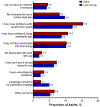Disparities in telehealth access, not willingness to use services, likely explain rural telehealth disparities
- PMID: 37042413
- PMCID: PMC10330004
- DOI: 10.1111/jrh.12759
Disparities in telehealth access, not willingness to use services, likely explain rural telehealth disparities
Abstract
Purpose: Although telehealth access and utilization have increased during the pandemic, rural and low-income disparities persist. We sought to assess whether access or willingness to use telehealth differed between rural and non-rural and low-income and non-low-income adults and measure the prevalence of perceived barriers.
Methods: We conducted a cross-sectional study using COVID-19's Unequal Racial Burden (CURB) online survey (December 17, 2020-February 17, 2021), which included 2 nationally representative cohorts of rural and low-income Black/African American, Latino, and White adults. Non-rural and non-low-income participants from the main, nationally representative sample were matched for rural versus non-rural and low-income versus non-low-income comparisons. We measured perceived telehealth access, willingness to use telehealth, and perceived telehealth barriers.
Findings: Rural (38.6% vs 44.9%) and low-income adults (42.0% vs 47.4%) were less likely to report telehealth access, compared to non-rural and non-low-income counterparts. After adjustment, rural adults were still less likely to report telehealth access (adjusted prevalence ratio [aPR] = 0.89, 95% CI = 0.79-0.99); no differences were seen between low-income and non-low-income adults (aPR = 1.02, 95% CI = 0.88-1.17). The majority of adults reported willingness to use telehealth (rural = 78.4%; low-income = 79.0%), with no differences between rural and non-rural (aPR = 0.99, 95% CI = 0.92-1.08) or low-income versus non-low-income (aPR = 1.01, 95% CI = 0.91-1.13). No racial/ethnic differences were observed in willingness to use telehealth. The prevalence of perceived telehealth barriers was low, with the majority reporting no barriers (rural = 57.4%; low-income = 56.9%).
Conclusions: Lack of access (and awareness of access) is likely a primary driver of disparities in rural telehealth use. Race/ethnicity was not associated with telehealth willingness, suggesting that equal utilization is possible once granted access.
Keywords: COVID-19; low-income disparities; racial/ethnic disparities; rural disparities; telehealth.
© 2023 National Rural Health Association. This article has been contributed to by U.S. Government employees and their work is in the public domain in the USA.
Conflict of interest statement
Figures



References
-
- Perrin A Mobile Technology and Home Broadband 2021. Pew Research Center. Published June 3, 2021. https://www.pewresearch.org/internet/2021/06/03/mobile-technology-and-ho...
Publication types
MeSH terms
Grants and funding
LinkOut - more resources
Full Text Sources
Medical
Miscellaneous

